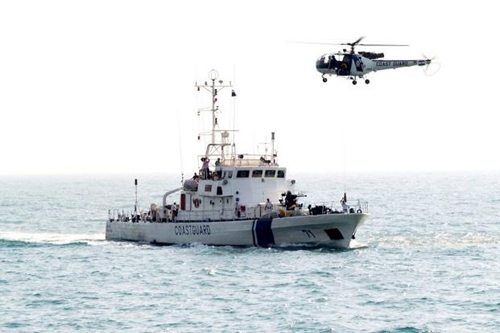 Chennai/ New Delhi, Oct 15: The police on Monday questioned the crew of a US registered ship with armed guards aboard, accused of illegally transporting weapons and ammunition in Indian waters.
Chennai/ New Delhi, Oct 15: The police on Monday questioned the crew of a US registered ship with armed guards aboard, accused of illegally transporting weapons and ammunition in Indian waters.
The vessel was intercepted by the Indian Coast Guard about 15 nautical miles east of Tuticorin on October 12. Security forces seized 31 assault rifles and around 5,000 rounds of ammunition from the MV Seaman Ohio.
The 35 persons who were on board the ship, including its crew, have been booked for illegally carrying weapons and ammunition. The ship had 10 crew members and 25 armed security guards from India, Britain, Estonia, and Ukraine, coast guard officials said. Eight of its members are Indians.
Coast guard official Santosh Kumar Singh said the ship is owned by a Virginia-based security company, AdvanFort, but is registered in Sierra Leone.
Tuticorin district collector M Ravi Kumar on Monday made a spot assessment of the ship. "A report has already been sent to the government by the police and on Tuesday, I have a meeting with the superintendent of police on this issue," he said.
The police said the ship's captain told investigators that AdvanFort provides armed escorts to merchant vessels travelling in pirate-infested waters in the Indian Ocean. AdvanFort could not immediately be reached for comment.
An FIR was also registered against the 10 crew members of the vessel and 25 guards under the Arms Act for illegally carrying weapons and ammunition.
A case under the Essential Commodities Act, too, has been registered after the crew bought 1,500 litres of diesel illegally with the help of a local shipping agent.
The coast guard detained the ship on Saturday after Indian security agencies received information about weapons being transported on the vessel.
Singh said the ship's crew told the coast guard that documents for the weapons were with the company. The police said they filed the complaint after the crew failed to produce the documents over two days.
India is very sensitive about the presence of armed security guards on merchant ships after the shooting deaths of two fishermen by armed Italian marines last year.
The marines were part of a military security team on a cargo ship when they fired at the fishermen, mistaking them for pirates. The two Italians are facing trial in India for the deaths.





Comments
Add new comment